Why do brown spots appear on cucumber leaves and what to do to get rid of them
When you grow cucumbers, you may find various spots on the leaves. This is the first sign that the plant is not healthy. A neglected disease can lead to significant loss of crops, so it is important to identify the cause and start solving the problem as quickly as possible. What to do if brown spots appear on the leaves of cucumbers, we will tell you in the article.
The content of the article
Causes of the appearance of brown spots on the leaves of cucumbers
The reasons for the appearance of spots on cucumbers can be different: improper care, pests, infectious diseases.
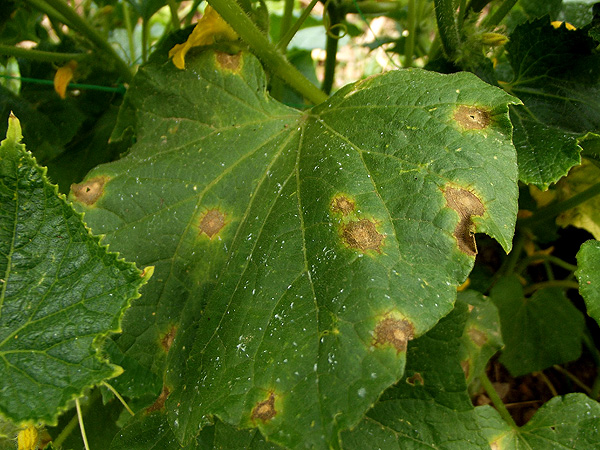
Peronosporosis
Peronosporosis, or false powdery mildew, Is an infectious rapidly progressive disease. In the absence of an urgent treatment the plants die.
First, light yellow or light green spots appear on the leaves in the form of a mosaic, then a gray bloom with purple blotches appears. The leaves quickly turn brown, turn outward and dry out. The affected area grows, in the end the plant dies. Cucumbers are susceptible to infection at any stage of growth.
If the fruits have already formed, they stop developing, acquire a white-green color, become tasteless. With high humidity, thickening of plantings and high temperatures, spores spread at a high speed to neighboring plants.
Cladosporium
Cladosporium, or olive spot, is a fungal disease that affects all terrestrial parts of the plant. First, small light gray spots appear on the leaves, then they acquire an olive-gray color with a light border around the edge. On the back of the sheet, dried spots are covered with a cobweb. Then they collapse, and holes remain in the leaves. On the stems, oblong dry spots of gray color are formed.
Fruits have a gray-olive bloom and depressed oily spots ranging in size from 5 to 15 mm. Gradually, the surface dries up, and the flesh rots. Affected fruits become bumpy, can bend sharply at the site of injury.
Attention! In conditions of high humidity and low temperatures, cucumbers are more likely to infect fungal diseases. Don't over-water and cover your plants during heavy rainfall.
Anthracnose
Other name anthracnose - copperhead. This is a fungal disease that affects the entire plant, but the fruits are most affected. On the seedlings, depressed brown spots form in the area of the root collar.
On the leaves of adult plants, light yellow or pale green small weeping spots first appear. Gradually, they grow up to 4 cm, becoming copper-brown. The entire leaf turns brown and becomes very brittle, holes can form.
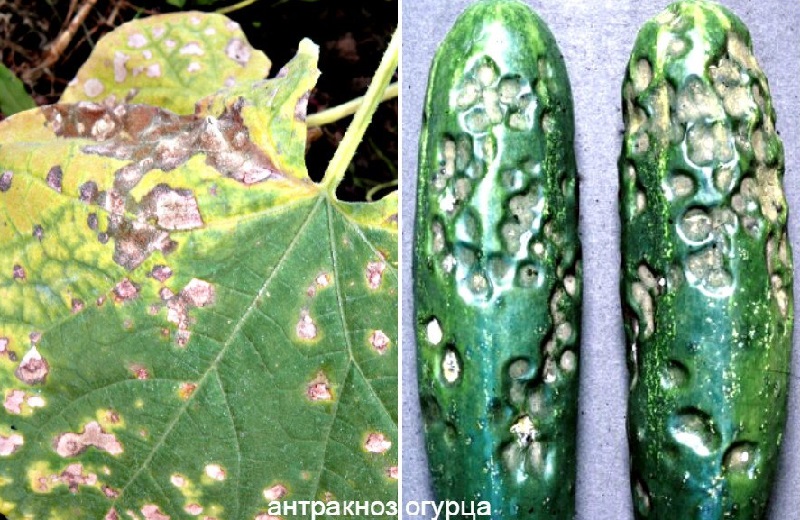
At high humidity, the leaf rots, and in dry weather it dries up. Sores appear on the fruits - oblong depressed weeping spots of light brown or pinkish color of various sizes. They grow and deepen up to 4 mm.
Cucumbers become bitter, darken, shriveled and rot. Such fruits cannot be eaten. Yellow-brown oblong spots are formed on the stem, often they encircle the shoot, it breaks, and the plant dies. At high humidity, ulcers are covered first with pink and then black bloom.
Angular spotting
Angular spot, or bacteriosis, affects a plant at any stage of development and growth. Infection often occurs from the lower or cotyledonous leaves. Single angular wet spots are formed on the underside of the plate.
In wet weather, yellow mucus is released from them, in dry spots they dry out and turn pale. On the front side of the leaf, these places become pale yellow, then brown. After a few days, they dry out and can be perforated. With a large area of damage, the leaf crumbles, only veins remain.
The pathogen is transferred to the plant with rain, wind, debris of infected vegetation, contaminated tools during trimming... Fruits slow down in development and lose taste, rot faster.
Important! Treat tools often and wash your hands while working to avoid spreading pathogenic bacteria to nearby plants.
Ascochitosis
Ascochitosis, or black stem rot, is a fungal disease that develops with the plant. Spores are stored in seeds, waiting for the right time. The disease affects the outer part of the plant, does not completely destroy it, but significantly worsens the condition and adversely affects the harvest. Doesn't appear for a long time.
The first signs are gray bloom on the stem. Gradually, it turns into white spots, then black rot forms. When fruits begin to grow, the lower layer of leaves turns brown. Gradually, the disease rises up the plant. Affected cucumbers begin to wilt and rot from the inside. Sometimes the fruits become covered with sores, rusty bloom and mucus. Pathogenic spores are carried by the wind to neighboring plants.
Rhizoctonia
This fungal disease affects the root part of the stem and cotyledonous leaves, it captures the entire plant except flowers. Leaves and fruits are covered with brown spots. Part of the plant that touches the surface of the earth is primarily affected.
Alternaria
Alternaria, or dry spotting of cucumbers, is a fungal disease. The main spore carrier is aphids. Scattered small brown spots first cover the lower leaves of the plant, gradually increase and merge into a large spot, affecting half of the leaf plate. Due to the violation of the process of photosynthesis, the development of plants and fruits slows down, worse ovaries are formed... Gradually, the disease covers the entire plant.
Why is there a problem in the greenhouse
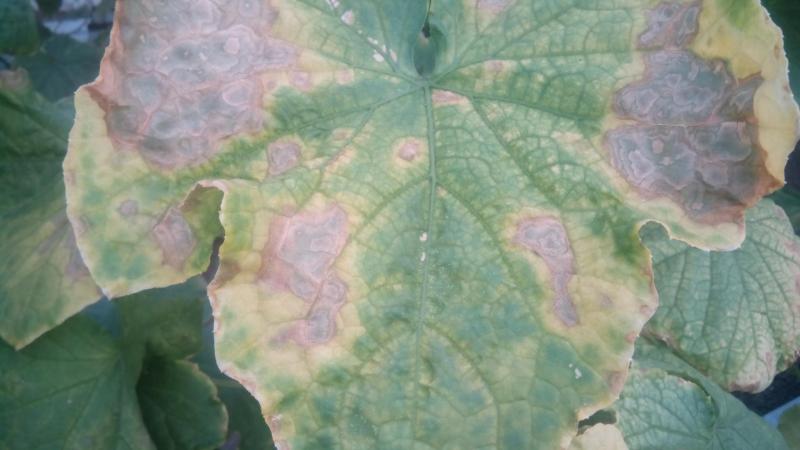
Cucumber is a very delicate culture that requires special attention and care... For an earlier harvest, the first plantings are made in greenhouses. Such a shelter does not protect plants from diseases. An improper ventilation system can cause sudden temperature changes, and its complete absence leads to very high humidity. In such conditions (more often from 70%), most of the bacteria and fungi feel great and actively develop.
Important! Do not create drafts while airing. Try to do this during a warm time of the day.
Lack of light and dense planting do not allow the plant to fully develop. Depleted soil, which does not change for several seasons in a row, accumulates fungal spores and larvae of various pests.
In the open field
Outdoors, the risk of high humidity is less, unless the rainy season begins. However, there is a risk of sudden changes in temperature during the day and night. An improperly organized irrigation system can also lead to rotting or, conversely, drying out of plants, which will weaken them and make them more vulnerable to pests and pathogens.
How to get rid of brown spots
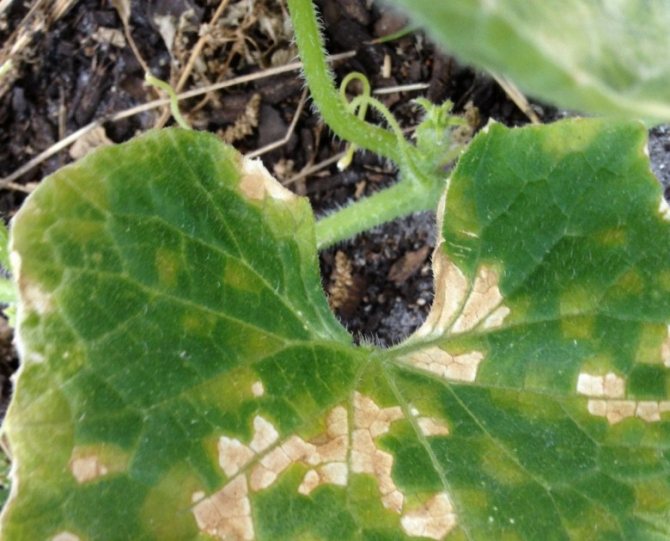
In some cases, the abundant treatment of the affected areas with an iodine solution helps to stop the development of the disease. In 1 st. water you need to stir 2 drops of the drug and immediately process it, without letting it fizzle out.
Purchased funds
Industrial preparations are divided into fungicides (antifungal) and insecticides, acaricides (for insect control).
The former include Bordeaux liquid, copper sulfate, Fitosporin, Hom, Kwardis, Ridomil Gold and others. Some of them can be used in conjunction with insecticides.
In the fight against insects, the preparations "Iskra", "Fitoverm", "Aktellik", "Commander" and others have proven themselves well.
Traditional methods
If the disease is detected at the initial stage, you can try to defeat it with folk remedies. They are harmless, cheap, and easy to prepare.
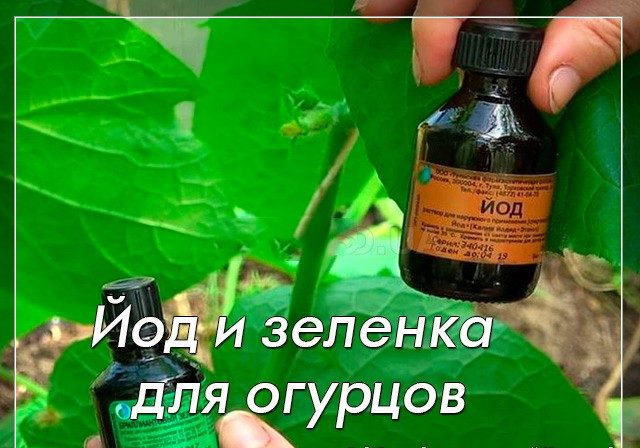
How to treat:
- A good remedy for cucumber diseases is woody ash... It can be used to powder plants, sprinkle the soil around. You can prepare a solution of 1 tbsp. ash and 10 liters of water, let it brew for one day, spray and water the cucumbers at the root. This tool also serves top dressing.
- In some cases, a generous sprinkling of mustard helps. To do this, dissolve 2 tbsp in 10 liters of water. l. mustard powder.
- Light pink solution of potassium permanganate is widely used. You can regularly spray and water the plants with products with the addition of iodine and brilliant green: 20 drops of each drug in a bucket of water.
- The causative agents of many diseases die from an acidic environment. For this, 1 liter of milk whey is stirred in 10 liters of water. Cucumber plantings are thoroughly irrigated with this solution. The same solution is made using milk and a few drops of iodine in a bucket of water.
- To prepare a medicinal solution, you can insist on water for several days celandine, dandelions, onion peels or chopped garlic.
During processing, try to cover the area around the cucumber plantations. Pests can get on plants from neighboring areas.
Timing and frequency of treatments
Treatments with purchased products are carried out strictly following the instructions, observing the dosage, timing and time of day (some work more effectively in the morning treatment, others - in the evening)... These are powerful tools, so 2 treatments are sufficient.
Treatment with folk remedies must be carried out throughout the season. This is done regularly, every 7-10 days. To prevent large losses, the plants are inspected daily, if signs of disease are detected, the affected parts are removed and processing is immediately started. With a large scale of infection (more than 1/3 of the plant), special chemicals cannot be dispensed with. If the plant is affected by 2/3 or more, it must be removed and burned.
Rules of conduct
An important condition for the multiplication of harmful bacteria and fungi is high humidity. For more successful results in the fight against them, watering must be stopped for 2-4 days or reduced. It is necessary to process not only the affected part. Spores and bacteria could settle in the ground and on the inside of the greenhouse.
Preventive measures
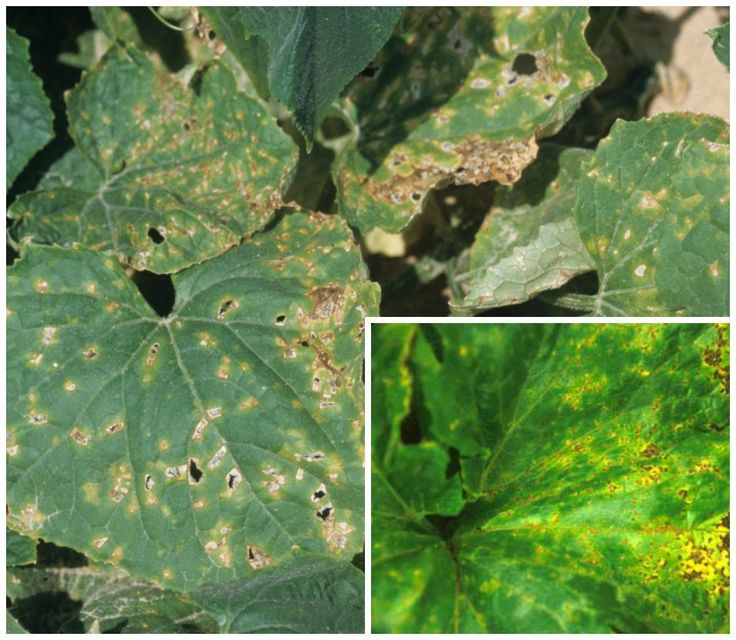
Before planting, the seeds are soaked in a light pink solution of potassium permanganate. It is not recommended to thicken the plantings, observe a distance of at least 15-20 cm. Preventive treatments with folk remedies begin with the appearance of a second leaf. Spraying and root dressing with nitrogen fertilizers and mullein infusion (1 liter per 10 liters of water) is used.
After the last harvest, all plant residues are burned. In the greenhouse, not only surfaces are washed and treated: microorganisms accumulate in cracks and joints, therefore, special attention is paid to such secluded places. Replacement of the top layer of soil is periodically required.
Attention!Favorable predecessors of cucumbers - rye and oats.
Tips from experienced gardeners
To enjoy a good harvest, grow varieties that are resistant to disease and temperature extremes. Choose well-lit, sunny places for planting, avoid drafts. Water and process cucumbers only with warm water.The plant needs a constant supply of nutrients, alternate regular feeding and processing with different formulations. The first ovaries and stepsons it's better pinch for a larger harvest.
Conclusion
Cucumber is a very capricious and tender culture. To obtain a good harvest for a long time, plants should not be left for self-growth. It is important to follow the crop rotation and care rules. If signs of disease are detected in time and treatment is started, up to 50% of crop losses can be avoided.